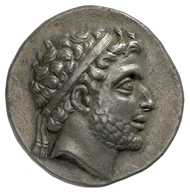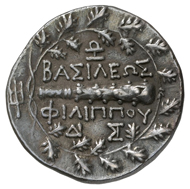with the kind permission of the MoneyMuseum, Zurich.
Why is it that for centuries – or rather thousands of years – the head has served as the motif for the side of a coin? And why has this changed in the last 200 years? Ursula Kampmann poses these questions in her book ‘MenschenGesichter,’ from which the texts for our new series are taken.
Shortly after the crushing defeat of the Romans at Cannae, Philip V came to an agreement with Hannibal, the presumed future ruler of the Italian peninsula. Philip’s objective was not, as the Roman’s assumed, sweeping them from the earth, but rather much more about ensuring safety on the home front. Illyria, the eastern coast of the Adriatic Sea, was to be kept free of enemy troops. Unfortunately, Rome caught word of the treaty. The Romans swore revenge on this foreign King, who, in their bitterest of hours, had allied himself with the enemy.
They drew on the Aetolians, a tribe in southwestern Greece, in order to create an amount of discord troublesome enough that it would require an intervention. This set up the perfect excuse for Rome to act. The Aetolians, however, turned out not to be quite as willing as expected, and Scipio wanted to cross over to Carthage. So, the Romans decided first to make peace with Macedonia. Once the Carthaginians were defeated, they could once again turn their thoughts and forces to Philip.
In the meantime, he had made use of the then right of every Hellenistic king to expand his kingdom at the expense of weaker regions. And some of the confederates of Rome had complained about him to the Senate: not the weaker regions, mind you, that were under threat of falling victim to Philip, but rather the rulers and cities who themselves had hoped to acquire the weaker regions for themselves. This cry for help came at the exact right moment, and Rome acted immediately. Without going into details about the negotiations, Roman envoys presented Philip with unattainable ultimatums – and then Rome went to war. The legions broke up the Macedonian kingdom that had grown over generations and confined it to the borders that it had during the time of Philip II.
Philip V, King of Macedonia (221-179 BC). Didrachm, 188/87-179 BC. Head of the king diademed, facing right. Rev. club in oak wreath. © MoneyMuseum, Zurich.
The king’s last years, during which the didrachm pictured here was coined, were marked by Roman despotism. Whoever had a dispute with Macedonia had only to turn to the Senate, who would then tell Philip to back down. And Philip did everything humanly possible to keep the Romans happy. All the same, he still managed to leave his kingdom to his son Perseus, against whom the Romans declared war in 171 BC for no reason at all. All of Perseus’ attempts at negotiation were refused. In 168 BC, Macedonia was destroyed, the monarchy abolished, and the country was divided up into four regions which were forbidden from communicating with one another. Quite a severe punishment for a treaty entered into at the wrong time!
In the next chapter, you’ll learn about what role coinage played for C. Julius Caesar after crossing the Rubicon.
All sections of the series can be found here.
The book ‘MenschenGesichter’ is available in printed form from the Conzett Verlag website. It soon will be translated to English …







